1999 HONDA ODYSSEY light
[x] Cancel search: lightPage 4 of 343
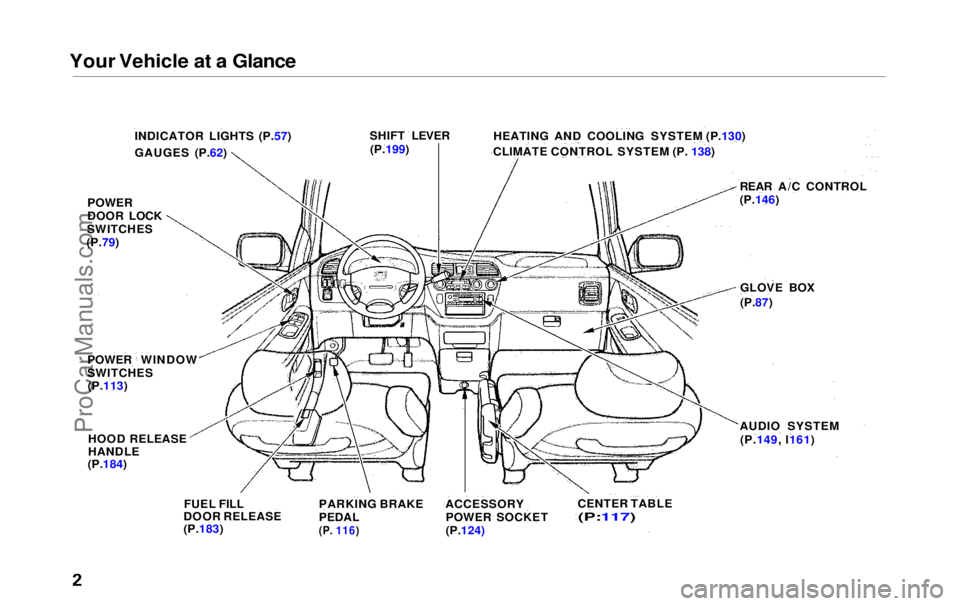
Your Vehicle at a Glance
INDICATOR LIGHTS (P.57)
GAUGES (P.62) HEATING AND COOLING SYSTEM (P.130)
CLIMATE CONTROL SYSTEM (P. 138)
SHIFT LEVER
(P.199)
REAR A/C CONTROL
(P.146)
GLOVE BOX
(P.87)
AUDIO SYSTEM (P.149, l161)
CENTER TABLE
(P:117)
ACCESSORY
POWER SOCKET
(P.124)
PARKING BRAKE
PEDAL
(P.
116)
FUEL FILL
DOOR RELEASE
(P.183)
HOOD RELEASE
HANDLE
(P.184)
POWER
DOOR LOCK
SWITCHES
(P.79)
POWER WINDOW
SWITCHES(P.113)ProCarManuals.comMain Menu s t
Page 5 of 343

Your Vehicle at a Glance
*
:
To use the horn, press the pad around the "H" logo.
TRACTION CONTROL SYSTEM
(P.207) HEADLIGHTS/
TURN SIGNALS
(P.66/68)
HAZARD WARNING
LIGHTS
(P.70)
DIGITAL CLOCK
(P.117)
REAR WINDOW
DEFOGGER(P.71)
LIGHT CONTROL
SWITCH (P.125)
WINDSHIELD
WIPERS/WASHERS
(P.68/70)
CRUISE
CONTROL
(P.73)
HORN*
STEERING WHEEL
ADJUSTMENT (P.72)
POWER SLIDING
DOOR SWITCHES(P.90)
MIRROR
CONTROLS (P.115)
REMOTE AUDIO
CONTROLS
(P.179)
CRUISE
CONTROL
(P.73)
ProCarManuals.comMain Menu s t
Page 6 of 343
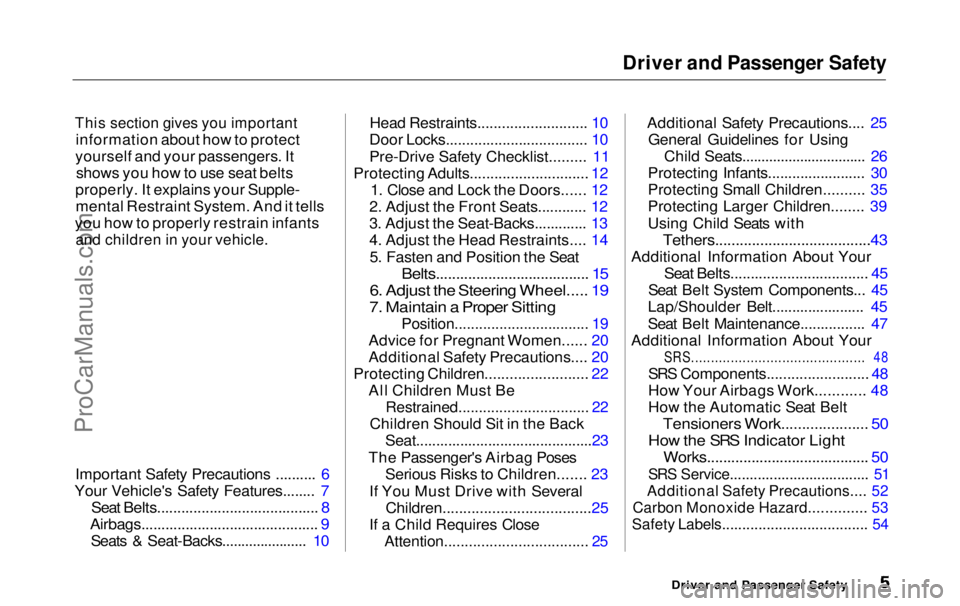
Driver and Passenger Safety
This section gives you important
information about how to protect
yourself and your passengers. It shows you how to use seat belts
properly. It explains your Supple- mental Restraint System. And it tells
you how to properly restrain infants
and children in your vehicle.
Important Safety Precautions .......... 6
Your Vehicle's Safety Features........ 7
Seat Belts........................................ 8
Airbags............................................ 9
Seats & Seat-Backs...................... 10 Head Restraints........................... 10
Door Locks................................... 10
Pre-Drive Safety Checklist......... 11
Protecting Adults............................. 12 1. Close and Lock the Doors...... 12
2. Adjust the Front Seats............ 12
3. Adjust the Seat-Backs............. 13
4. Adjust the Head Restraints.... 14
5. Fasten and Position the Seat
Belts...................................... 15
6. Adjust the Steering Wheel..... 19
7. Maintain a Proper Sitting
Position................................. 19
Advice for Pregnant Women...... 20
Additional Safety Precautions.... 20
Protecting Children......................... 22
All Children Must Be
Restrained................................ 22
Children Should Sit in the Back Seat............................................23
The Passenger's Airbag Poses Serious Risks to Children....... 23
If You Must Drive with Several Children....................................25
If a Child Requires Close
Attention................................... 25
Additional Safety Precautions.... 25
General Guidelines for Using Child Seats................................ 26
Protecting Infants........................ 30
Protecting Small Children.......... 35
Protecting Larger Children........ 39
Using Child Seats with
Tethers......................................43
Additional Information About Your
Seat Belts.................................. 45
Seat Belt System Components... 45
Lap/Shoulder Belt....................... 45
Seat Belt Maintenance................ 47
Additional Information About Your
SRS............................................ 48
SRS Components......................... 48
How Your Airbags Work............ 48
How the Automatic Seat Belt
Tensioners Work..................... 50
How the SRS Indicator Light
Works........................................ 50
SRS Service................................... 51
Additional Safety Precautions.... 52
Carbon Monoxide Hazard.............. 53
Safety Labels.................................... 54
Driver and Passenger SafetyProCarManuals.comMain Menu s t
Page 9 of 343
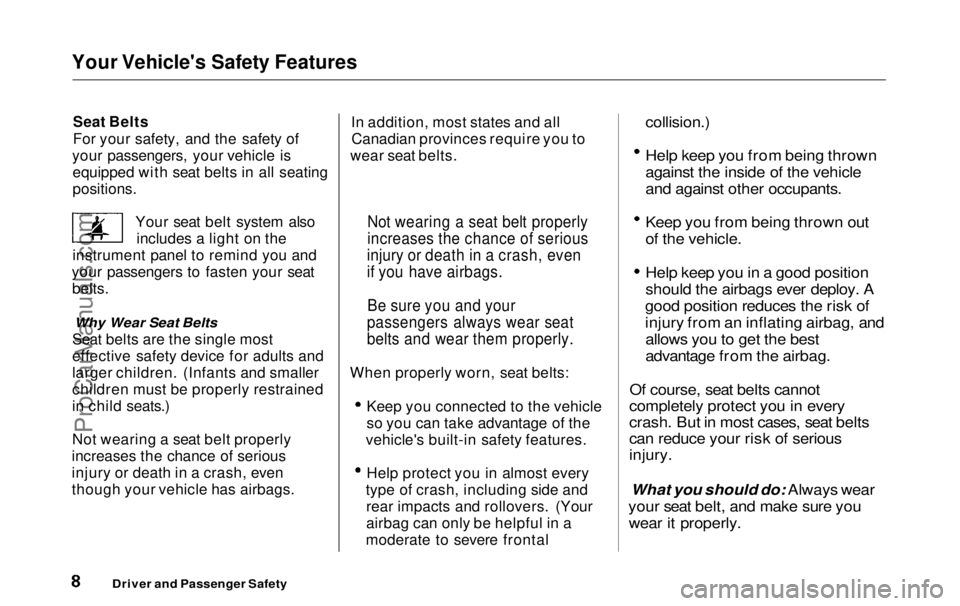
Your Vehicle's Safety Features
Seat Belts
For your safety, and the safety of
your passengers, your vehicle is equipped with seat belts in all seating
positions.
Your seat belt system alsoincludes a light on the
instrument panel to remind you and
your passengers to fasten your seat belts.
Why Wear Seat Belts
Seat belts are the single most
effective safety device for adults and
larger children. (Infants and smaller
children must be properly restrained
in child seats.)
Not wearing a seat belt properly
increases the chance of serious
injury or death in a crash, even
though your vehicle has airbags. In addition, most states and all
Canadian provinces require you to
wear seat belts.
When properly worn, seat belts: Keep you connected to the vehicle
so you can take advantage of the
vehicle's built-in safety features. Help protect you in almost every
type of crash, including side and rear impacts and rollovers. (Your
airbag can only be helpful in a
moderate to severe frontal
collision.)
Help keep you from being thrown
against the inside of the vehicle
and against other occupants.
Keep you from being thrown out
of the vehicle.
Help keep you in a good position
should the airbags ever deploy. A
good position reduces the risk of
injury from an inflating airbag, and allows you to get the best
advantage from the airbag.
Of course, seat belts cannot
completely protect you in every
crash. But in most cases, seat belts
can reduce your risk of serious
injury.
What you should do: Always wear
your seat belt, and make sure you wear it properly.
Driver and Passenger Safety
Not wearing a seat belt properly
increases the chance of serious
injury or death in a crash, even
if you have airbags.
Be sure you and your
passengers always wear seat
belts and wear them properly.ProCarManuals.comMain Menu Table of Contents s t
Page 10 of 343
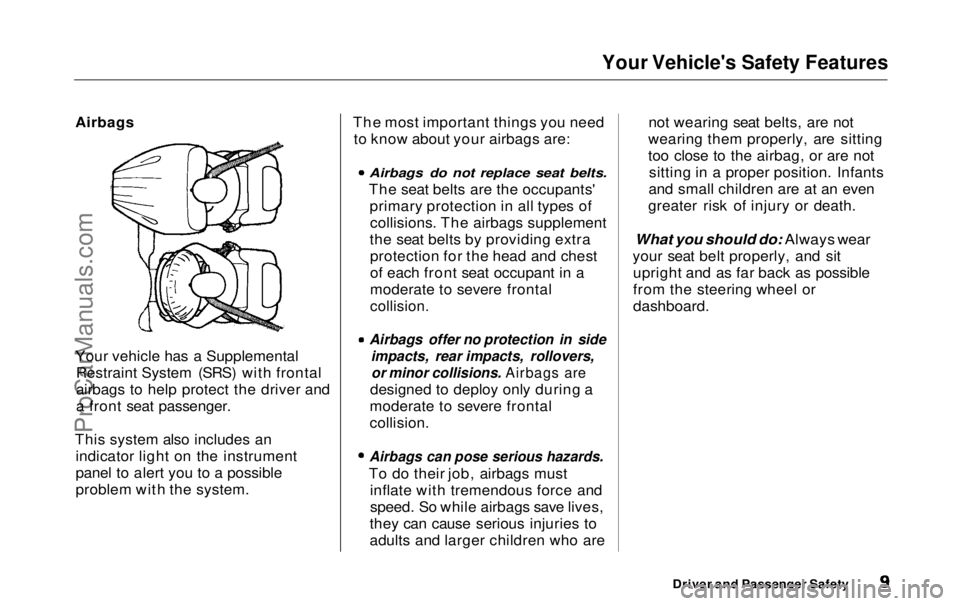
Your Vehicle's Safety Features
Airbags
Your vehicle has a Supplemental Restraint System (SRS) with frontal
airbags to help protect the driver and
a front seat passenger.
This system also includes an indicator light on the instrument
panel to alert you to a possible
problem with the system. The most important things you need
to know about your airbags are:
Airbags do not replace seat belts.
The seat belts are the occupants' primary protection in all types ofcollisions. The airbags supplement
the seat belts by providing extra protection for the head and chest
of each front seat occupant in a
moderate to severe frontal
collision.
Airbags offer no protection in side
impacts, rear impacts, rollovers,
or minor collisions. Airbags are
designed to deploy only during a
moderate to severe frontal
collision.
Airbags can pose serious hazards.
To do their job, airbags must inflate with tremendous force and
speed. So while airbags save lives,
they can cause serious injuries to
adults and larger children who are not wearing seat belts, are not
wearing them properly, are sitting
too close to the airbag, or are not sitting in a proper position. Infants
and small children are at an even
greater risk of injury or death.
What you should do: Always wear
your seat belt properly, and sit upright and as far back as possible
from the steering wheel or
dashboard.
Driver and Passenger SafetyProCarManuals.comMain Menu Table of Contents s t
Page 13 of 343
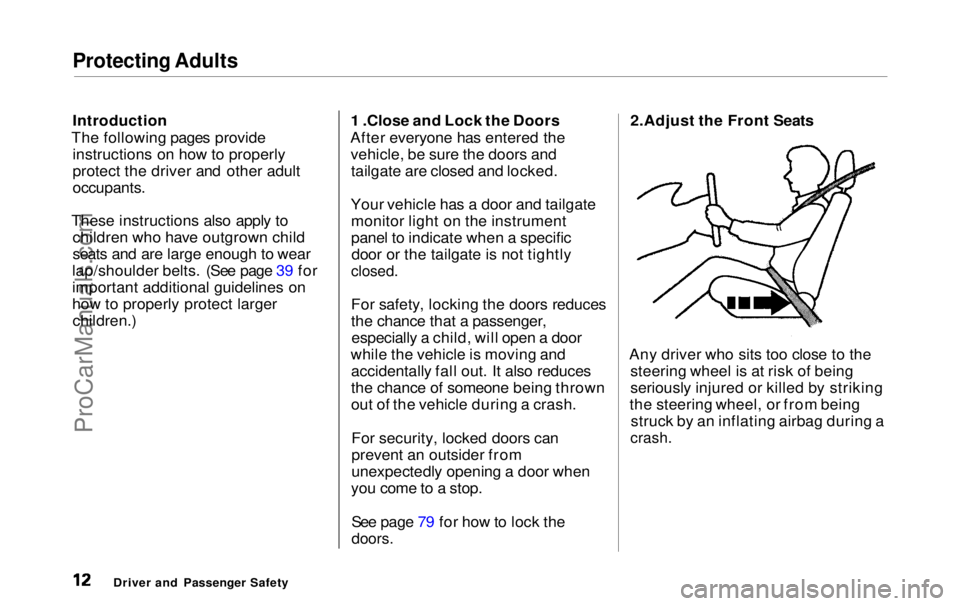
Protecting Adults
Introduction
The following pages provide instructions on how to properly
protect the driver and other adult
occupants.
These instructions also apply to children who have outgrown child
seats and are large enough to wear
lap/shoulder belts. (See page 39 for
important additional guidelines on
how to properly protect larger children.) 1 .Close and Lock the Doors
After everyone has entered the vehicle, be sure the doors andtailgate are closed and locked.
Your vehicle has a door and tailgate monitor light on the instrument
panel to indicate when a specificdoor or the tailgate is not tightly
closed.
For safety, locking the doors reduces
the chance that a passenger, especially a child, will open a door
while the vehicle is moving and accidentally fall out. It also reduces
the chance of someone being thrown
out of the vehicle during a crash.
For security, locked doors can
prevent an outsider from
unexpectedly opening a door when
you come to a stop.
See page 79 for how to lock the
doors.
2.Adjust the Front Seats
Any driver who sits too close to the steering wheel is at risk of being
seriously injured or killed by striking
the steering wheel, or from being struck by an inflating airbag during a
crash.
Driver and Passenger SafetyProCarManuals.comMain Menu Table of Contents s t
Page 46 of 343
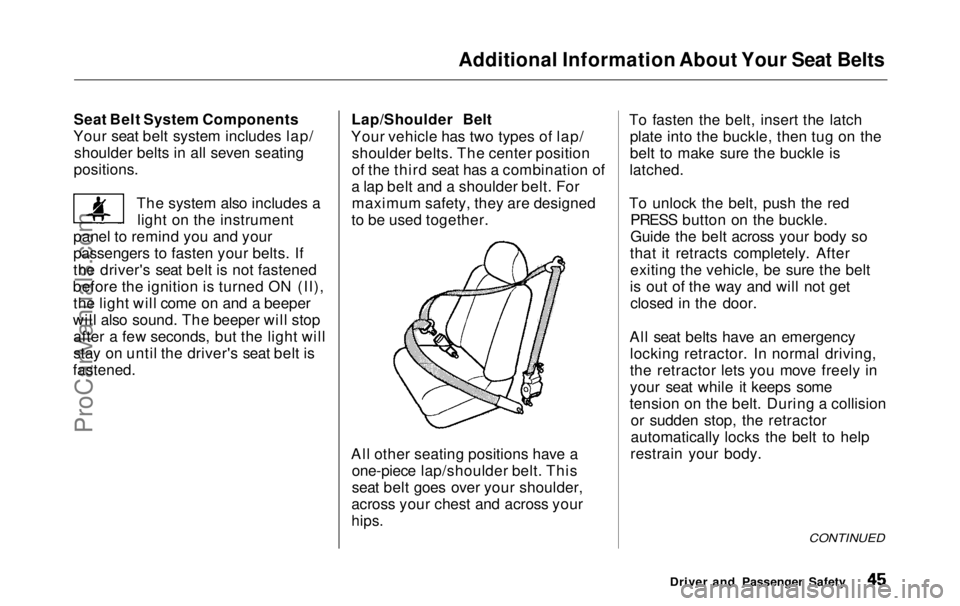
Additional Information About Your Seat Belts
Seat Belt System Components
Your seat belt system includes lap/ shoulder belts in all seven seating
positions.
The system also includes alight on the instrument
panel to remind you and your
passengers to fasten your belts. If
the driver's seat belt is not fastened
before the ignition is turned ON (II), the light will come on and a beeper
will also sound. The beeper will stop after a few seconds, but the light will
stay on until the driver's seat belt is
fastened.
Lap/Shoulder Belt
Your vehicle has two types of lap/ shoulder belts. The center position
of the third seat has a combination of
a lap belt and a shoulder belt. For maximum safety, they are designed
to be used together.
All other seating positions have a one-piece lap/shoulder belt. This
seat belt goes over your shoulder,
across your chest and across your
hips.
To fasten the belt, insert the latch
plate into the buckle, then tug on the
belt to make sure the buckle is
latched.
To unlock the belt, push the red PRESS button on the buckle.
Guide the belt across your body so
that it retracts completely. After exiting the vehicle, be sure the belt
is out of the way and will not get closed in the door.
All seat belts have an emergency locking retractor. In normal driving,
the retractor lets you move freely in
your seat while it keeps some
tension on the belt. During a collision or sudden stop, the retractor
automatically locks the belt to help
restrain your body.
CONTINUED
Driver and Passenger SafetyProCarManuals.comMain Menu Table of Contents s t
Page 49 of 343

Additional Information About Your SRS
SRS Components
Your Supplemental Restraint System (SRS) includes: Two front airbags. The driver's
airbag is stored in the center of
the steering wheel; the front
passenger's airbag is stored in thedashboard. Both are marked "SRS
AIRBAG." Automatic seat belt tensioners
that tighten the front seat beltsduring a moderate to severe
frontal collision. Sensors that can detect a
moderate to severe frontal
collision.
A sophisticated electronic system
that continually monitors the sensors, control unit, the airbag
activators, and all related wiring
when the ignition is ON (II). An indicator light on the
instrument panel that alerts you toa possible problem with the
system (see page 50). Emergency backup power in case
your vehicle's electrical system is
disconnected in a crash. How Your Airbags Work
If you ever have a moderate to
severe frontal collision, the sensors
will detect rapid deceleration and
signal the control unit to instantly
inflate the airbags and activate the
automatic seat belt tensioners.
Driver and Passenger SafetyProCarManuals.comMain Menu Table of Contents s t